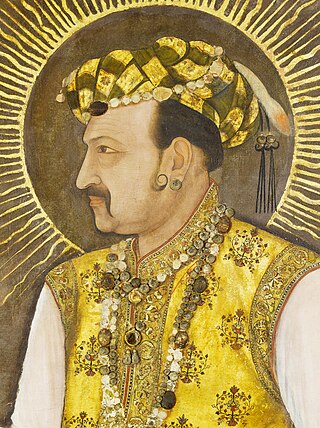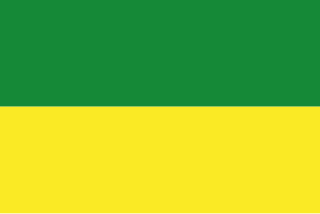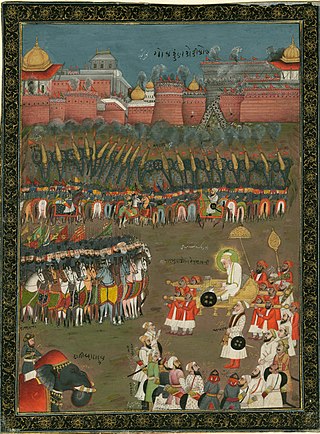
Nur-ud-din Muhammad Salim, known by his imperial name Jahangir, was Emperor of Hindustan from 1605 until his death in 1627, and the fourth Mughal Emperor.

The mahi-mahi or common dolphinfish is a surface-dwelling ray-finned fish found in off-shore temperate, tropical, and subtropical waters worldwide. It is also widely called dorado and dolphin. It is one of two members of the family Coryphaenidae, the other being the pompano dolphinfish. These fish are most commonly found in the waters around the Gulf of Mexico, Costa Rica, Hawaii and the Indian Ocean.

Mirza Nasir-ud-Din Muḥammad Shah was the thirteenth Mughal emperor from 1719 to 1748. He was son of Khujista Akhtar, the fourth son of Bahadur Shah I. After being chosen by the Sayyid Brothers of Barha, he ascended the throne at the young age of 16, under their strict supervision.

The Red Fort, also known as Lal Qila is a historic Mughal fort in Delhi, India, that served as the primary residence of the Mughal emperors. Emperor Shah Jahan commissioned the construction of the Red Fort on 12 May 1639, following his decision to relocate the Mughal capital from Agra to Delhi. Originally adorned in red and white, the fort's design is attributed to Ustad Ahmad Lahori, the architect behind the Taj Mahal. The Red Fort represents the pinnacle of Mughal architecture during Shah Jahan's reign, blending Persian palace influences with indigenous Indian architectural traditions.

Sheikhupura also known as Qila Sheikhupura, is a city and district in the Pakistani province of Punjab. Founded by the Mughal Emperor Jahangir in 1607, Sheikhupura is the 15th largest city of Pakistan by population and is the headquarters of Sheikhupura District. The city is an industrial centre and satellite town, and is located about 38 km northwest of Lahore. It also borders Sialkot, Gujranwala, Nankana Sahib and Kasur districts of Punjab, Pakistan.

The Mughal dynasty or the House of Babur, was a branch of the Timurid dynasty founded by Babur that ruled the Mughal Empire from its inception in 1526 till the early eighteenth century, and then as ceremonial suzerains over much of the empire until 1857.

Wah Gardens, also known as Mughal Garden Wah, is a garden-complex dating back to the era of the Mughal Emperor Akbar the Great (1542-1605), located at Wah village, of Hasan Abdal, in Punjab, Pakistan. The site, which was largely abandoned after Mughal rule and lay in ruins, is now being restored by the Pakistan Department of Archaeology.

Mughlai cuisine consists of dishes developed or popularised in the early-modern Indo-Persian cultural centres of the Mughal Empire. It represents a combination of cuisine of the Indian subcontinent with the cooking styles and recipes of Central Asian and Islamic cuisine. Mughlai cuisine is strongly influenced by the Turkic cuisine of Central Asia, the region where the early Mughal emperors originally hailed from, and it has in turn strongly influenced the regional cuisines of Northern India, Pakistan and Bangladesh.

Ibrahim Shah Sultan Balkhi, also known by his sobriquet, Mahisawar, was a 16th-century Muslim saint. He is associated with the spread of Islam in Sandwip and Bogra.

Abu'l-Fath Jalal-ud-din Muhammad Akbar, popularly known as Akbar the Great, and also as Akbar I, was the third Mughal emperor, who reigned from 1556 to 1605. Akbar succeeded his father, Humayun, under a regent, Bairam Khan, who helped the young emperor expand and consolidate Mughal domains in the Indian subcontinent. He is generally considered one of the greatest emperors in Indian history and led a successful campaign to unify the various kingdoms of Hindūstān or India proper.

The Mughal Empire had a number of imperial flags and standards. The principal imperial standard of the Mughals was known as the alam. It was primarily moss green. It displayed a lion and sun facing the hoist of the flag. The Mughals traced their use of the alam back to Timur.

Mir Shihab-ud-Din Siddiqi, known by his title Ghaziuddin Khan, was a leading military general and noble of Central Asian origin in the Mughal Empire. He was a favoured member of emperor Aurangzeb's court, and the father of Chin Qilich Khan, founder of Hyderabad State. Under Aurangzeb, he distinguished himself in key battles over the Deccan, and held the governorship of Berar Subah. He briefly served as the governor of Gujarat Subah during the reign of Aurangzeb's successor Bahadur Shah, and died in office. He is buried in a madrasa complex he founded during his lifetime, known as Madrasa Ghaziuddin Khan, which is located in Old Delhi.

The Mughal Empire was an early modern empire in South Asia. At its peak, the empire stretched from the outer fringes of the Indus River Basin in the west, northern Afghanistan in the northwest, and Kashmir in the north, to the highlands of present-day Assam and Bangladesh in the east, and the uplands of the Deccan Plateau in South India.

Bagarius yarrelli, also known as the goonch catfish, giant devil catfish, or simply Goonch, is a very large species of catfish in the genus Bagarius found in rivers in the Indian subcontinent. The species reaches up to 2 m (6.6 ft) in length. It may be synonymous with B. bagarius.

Ratlam State was a 13 gun salute princely state in India, part of the Malwa Agency of Central India during the British Raj.

The siege of Golconda was a siege of Golconda Fort between the Qutb Shahi dynasty and the Mughal Emperor Aurangzeb, occurring in January 1687, lasting 8 months. The fort was home of the Kollur Mine. The Golconda Fort was considered to be an impregnable fort on the Indian subcontinent. At the end of the siege, Aurangzeb and the Mughals entered Golconda victorious.

Mughal weapons significantly evolved during the ruling periods of its various rulers. During its conquests throughout the centuries, the military of the Mughal Empire used a variety of weapons including swords, bows and arrows, horses, camels, elephants, some of the world's largest cannons, muskets and flintlock blunderbusses.

Hakim's Tomb is a 16th-century tomb located in the city of Hasan Abdal, Pakistan, across from the Gurdwara Panja Sahib. The tomb complex also includes the Tomb of Lala Rukh, traditionally attributed to a Mughal princess. The tomb was built for two physicians (Hakims) at the Mughal court, the brothers Hakim Abdul Fateh Gilani Masiuddin, and Hakim Humayun Khwaja Gilani.

The historical shrine of Dayera Sharif Khanqah, commonly known as Bara Dayera Sharif, is situated in the Azimpur locality of Dhaka. The Persian word Dayera means "circle" or "work area". As a rule, the heirs of the Dayera Sharif never go outside the area, except for pilgrimage. The Azimpur Dayera Sharif was established by Shah Sufi Sayed Muhammad Dayem who came at Dhaka in 1766-68 AD. It is currently under the supervision of his seventh generation. Shah Sufi Syed Shah Ahmedullah Jubayer has been the overall supervisor of Dayera Sharif since 1998. The successor of the Sufi dynasty is known as Gaddi Nashin, who sits on the Gaddi to serve people.

Maharaja Anup Singh was the Rathore Rajput ruler of the Kingdom of Bikaner during 1669–1698. Like his predecessors he was a vassal of the imperial Mughal Empire and participated in several Mughal campaigns in the Deccan region. He led the Mughal charge that resulted in the fall of the Golconda Sultanate for which Mughal Emperor Aurangzeb conferred the title of "Maharaja" upon him. He was a patron of scholars, poets, painters and musicians. He collected several manuscripts and established the Anup Sanskrit Library in his capital city of Bikaner.




















